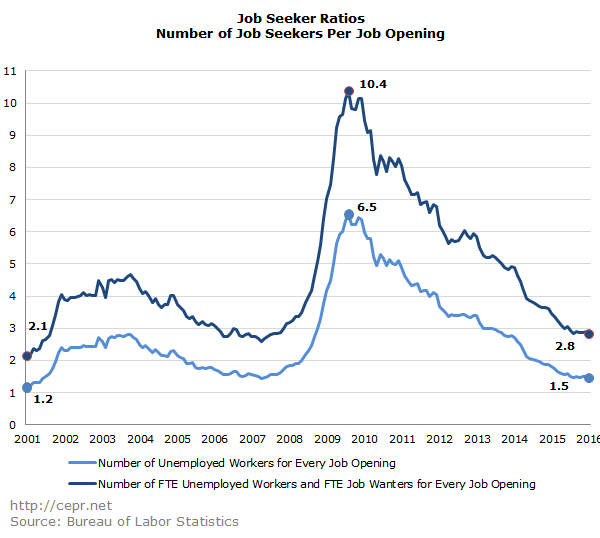March 17, 2016
Earlier this morning, the Bureau of Labor Statistics (BLS) released the January 2016 results from the Job Openings and Labor Turnover Survey (JOLTS). In its summary of the newest JOLTS data, the BLS notes: “Job openings remain at historically high levels, rising to 5.5 million (+260,000) in January.” In fact, the 5.5 million openings is the third-highest level since the inception of JOLTS in December 2000.
A greater number of job openings means that more employers are looking to hire. And if employers are competing to hire workers, they will have to bid up wages to attract workers to their firms. So other things equal, a higher number of vacancies should benefit workers by pushing up wages.
However, what remains salient from a wage-setting perspective is not the number of job openings per se but rather the ratio of job openings to unemployed workers. If more job openings force employers to compete for workers and bid wages up, unemployment has the opposite effect: it forces prospective workers to compete for jobs and thus pushes wages down. Think of it this way: unemployed workers are desperate for jobs and will work at even very low wages, because any wage is an improvement over unemployment. When unemployment is high, employers need not bid up wages to attract workers to their firms, since the unemployed are desperate to work anyways.
The figure below displays two variants of this ratio. The first is a simple two-month moving average of the ratio of unemployed workers to job openings. The second ratio is similar to the first, but with two differences. First, it includes not only unemployed workers but also job wanters – people who are not part of the labor force but say they want a job. (In order to be counted as “unemployed,” a prospective worker must have searched for a job sometime in the past four weeks.) Second, the data are based on the number of full-time equivalent (FTE) non-employed workers. This incorporates information on the underemployment of part-time workers seeking full-time jobs as well as the desired work hours of unemployed workers and job wanters. In December 2015 and January 2016, there were over 2.8 FTE prospective workers for every job opening – a ratio that is over 32 percent higher than the ratio from December 2000 and January 2001.







